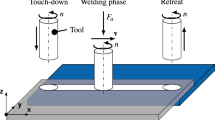Abstract
Despite its importance as a manufacturing process, the use of control loops to improve welding results is not generalized in industry. There seems to be a need for a framework where control engineers can work comfortably without depending on low-order identified models or black boxes. That framework consists of general, yet relatively simple transfer function models allowing controller synthesis, and lightweight simulation mechanisms to benchmark such controllers. This work is a first step in this endeavor, in which analytical 1-D and 2-D transfer functions of welding, which extend the classical Rosenthal models to the dynamic case, are introduced. Besides, for the 1-D case, a 2 × 2 multivariable control model is configured, and the design of a basic controller is also presented.








Similar content being viewed by others
References
Rosenthal D (1941) Mathematical theory of heat distribution during welding and cutting. Weld J 20:220–234
Adams CM (1958) Cooling rates and peak temperatures in fusion welding. Weld J 37:210s–215s
Pavelic V, Tanbakuchi R, Uyehara OA, Myers PS (1969) Experimental and computed temperature histories in gas tungsten arc welding of thin plates. Weld J Res Suppl 48:295–305
Eagar TW, Tsai NS (1983) Temperature fields produced by traveling distributed heat sources. Weld J Res Suppl 62:346–355
Nguyen NT, Ohta A, Matsuoka K, Suzuki N, Maeda Y (1999) Transient temperature of semi-infinite body subjected to 3-d moving heat sources. Weld J Res Suppl 78:265–274
Komanduri R, Hou ZB (2000) Thermal analysis of the arc welding process: Part i. general solutions. Metall and Mater Trans B 31:1353–1370
Jeong SK, Cho HS (1997) An analytical solution to predict the transient temperature distribution in fillet arc welds, vol 76
Ramos-Greza JA, Senb M (2019) Analytical, quasi-stationary wilson-rosenthal solution for moving heat sources. Int J Therm Sci 140:455–465
Wenji L, Liangyu L, Jianfeng Y, Haihua L, Lei Y (2015) A kind of analytical model of arc welding temperature distribution under varying material properties. Int J Adv Manuf Technol 81(5-8):1109–1116
Kollár D, Kövesdi B, Vigh LG, Horváth S (2019) Weld process model for simulating metal active gas welding. Int J Adv Manuf Technol 102(5-8):2063–2083
Goldak JA, Akhlaghi M (2005) Computational welding mechanics. Kluwer Academic Publishers, Boston
Lindgren LE (2012) Finite element modeling and simulation of welding part 1. J Therm Stress 24:141–192
Azar AS, As SK, Akselsen OM (2012) Determination of welding heat source parameters from actual bead shape. Comput Mater Sci 54:176–182
Goldak J, Bibby M, Moore J, House R, Patel B (1986) Computer modeling of heat flow in welds. Metall Mater Trans B 17:587–600
Nasiri MB, Enzingerb N (2019) Powerful analytical solution to heat flow problem in welding. Int J Therm Sci 135:601–612
Hale MB, Hardt DE (1990) Multivariable geometry control of welding part i: Process modeling. The American Society of Mechanical Engineers, 22
Doumanidis CC (1994) Multiplexed and distributed control of automated welding. IEEE Control Systems
Li XC, Farson D, Richardson R (2001) Weld penetration control system design and testing. Journal of Manufacturing Systems, 19(6)
Yamane S, Kaneko Y, Kitahara N, Ohshima K, Yamamoto M (1993) Neural network and fuzzy control of weld pool with welding robot. In: IEEE Industry Applications Conference
Zhang YM, Kovacevic R (1998) Neurofuzzy model-based predictive control of weld fusion zone geometry. IEEE Transactions on Fuzzy Systems 6(3):389–401
Liu YK, Zhang WJ, Zhang YM (2014) A tutorial on learning human welder’s behavior: s modeling, and control. J Manuf Process 16:123–136
Devesse W, de Baere D, Guillaume P (2014) The isotherm migration method in spherical coordinates with a moving heat source. Int J Heat Mass Transf 75:726–735
Devesse W, de Baere D, Guillaume P (2014) Design of a model-based controller with temperature feedback for laser cladding. Physics Procedia 56:211–219
Holm H, Kjeldsen HCE, Kristensen JK (2003) A reference architecture for the design of an industrial temperature feedback welding control system. J Mater Process Technol 139:499–504
Abukhshim NA, Mativenga PT, Sheikh MA (2006) Heat generation and temperature prediction in metal cutting: a review and implications for high speed machining. Int J Mach Tools Manuf 46:782–800
Kinsey SP, Haji-Sheikhh A, Lou DYS (1997) A thermal model for cure of thermoset composites. J Mater Process Technol 63:442–449
Clyne TW (1980) Heat flow in controlled directional solidification of metals. J Cryst Growth 50:684–690
Polianin AD (2002) Handbook of linear partial differential equations for engineers and scientists. Chapman & hall/CRC
Beck JV (1984) Green’s function solution for transient heat conduction problems. Int J Heat Mass Transfer 27:1235–1244
Özişik MN (1993) Heat conduction, 2nd edn. Wiley, New York
Dupont T, Hoffman J, Johnson C, Kirby RC, Larson MG, Logg A, Ridgway Scott L (2003) The Fenics project. Chalmers Finite Element Centre Chalmers University of Technology
Cverna F et al (2002) ASM ready reference: thermal properties of metals. ASM International
Cañas J, Picòn R, París F, Del Río JI (1996) A one-dimensional model for the prediction of residual stress and its relief in welded plates. Int J Mech Sci 38(7):735–751
Flemings MC (1974) Solidification processing. Metall Trans 5(10):2121–2134
DebRoy T, David SA (1995) Physical processes in fusion welding. Rev Mod Phys 67(1):85
Coniglio N, Cross CE (2020) Effect of weld travel speed on solidification cracking behavior. part 3: modeling. The International Journal of Advanced Manufacturing Technology, pp 1–13
Skogestad S, Postlethwaite I (2007) Multivariable feedback control: analysis and design, 2nd edn. Wiley, New York
Author information
Authors and Affiliations
Corresponding author
Additional information
Publisher’s note
Springer Nature remains neutral with regard to jurisdictional claims in published maps and institutional affiliations.
This manuscript was created on March 16, 2020. This work has been carried out in the Intelligent Systems & Energy research group of the University of the Basque Country UPV/EHU, and has been supported by the IT1256-19 research grant of the Basque Government.
Rights and permissions
About this article
Cite this article
Masenlle, M., Elso, J. & Ostolaza, J.X. Analytical 1-D and 2-D transfer functions of welding for control benchmarking purposes. Int J Adv Manuf Technol 111, 2117–2126 (2020). https://doi.org/10.1007/s00170-020-06257-y
Received:
Accepted:
Published:
Issue Date:
DOI: https://doi.org/10.1007/s00170-020-06257-y




